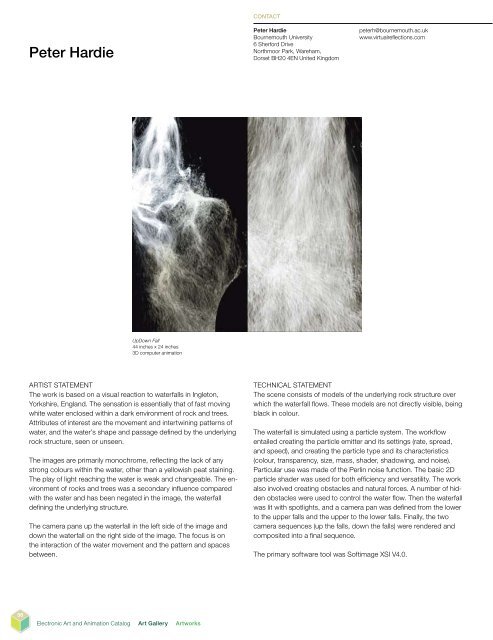Intersections - Nguyen Dang Binh
Intersections - Nguyen Dang Binh
Intersections - Nguyen Dang Binh
Create successful ePaper yourself
Turn your PDF publications into a flip-book with our unique Google optimized e-Paper software.
5<br />
Peter Hardie<br />
UpDown Fall<br />
44 inches x 24 inches<br />
3D computer animation<br />
ARTIST STATEMENT<br />
The work is based on a visual reaction to waterfalls in Ingleton,<br />
Yorkshire, England. The sensation is essentially that of fast moving<br />
white water enclosed within a dark environment of rock and trees.<br />
Attributes of interest are the movement and intertwining patterns of<br />
water, and the water’s shape and passage defined by the underlying<br />
rock structure, seen or unseen.<br />
The images are primarily monochrome, reflecting the lack of any<br />
strong colours within the water, other than a yellowish peat staining.<br />
The play of light reaching the water is weak and changeable. The environment<br />
of rocks and trees was a secondary influence compared<br />
with the water and has been negated in the image, the waterfall<br />
defining the underlying structure.<br />
The camera pans up the waterfall in the left side of the image and<br />
down the waterfall on the right side of the image. The focus is on<br />
the interaction of the water movement and the pattern and spaces<br />
between.<br />
Electronic Art and Animation Catalog Art Gallery Artworks<br />
CONTACT<br />
Peter Hardie<br />
Bournemouth University<br />
6 Sherford Drive<br />
Northmoor Park, Wareham,<br />
Dorset BH20 4EN United Kingdom<br />
peterh@bournemouth.ac.uk<br />
www.virtualreflections.com<br />
TECHNICAl STATEMENT<br />
The scene consists of models of the underlying rock structure over<br />
which the waterfall flows. These models are not directly visible, being<br />
black in colour.<br />
The waterfall is simulated using a particle system. The workflow<br />
entailed creating the particle emitter and its settings (rate, spread,<br />
and speed), and creating the particle type and its characteristics<br />
(colour, transparency, size, mass, shader, shadowing, and noise).<br />
Particular use was made of the Perlin noise function. The basic 2D<br />
particle shader was used for both efficiency and versatility. The work<br />
also involved creating obstacles and natural forces. A number of hidden<br />
obstacles were used to control the water flow. Then the waterfall<br />
was lit with spotlights, and a camera pan was defined from the lower<br />
to the upper falls and the upper to the lower falls. Finally, the two<br />
camera sequences (up the falls, down the falls) were rendered and<br />
composited into a final sequence.<br />
The primary software tool was Softimage XSI V4.0.

















